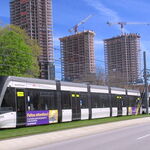Adam Forrest
Wed 7 Sep 2016 15.03 BSTLast modified on Fri 11 May 2018 13.09 BST
[...]
Theatre manager Martin, 42, travels on the new Thameslink train from Brighton to London Blackfriars at rush hour each morning. “The new train feels quite odd because it’s one long tube-type carriage,” he says. “If I do get a seat, the lack of tables makes trying to get any work done on your laptop really awkward and difficult. And if I don’t get a seat and I’m forced to stand, it’s not any more comfortable than standing on the old train – you’re still jiggling around the doorway for an hour and 20 minutes.
“I can remember when the old train had a buffet cart about a decade ago,” he adds. “It feels like they’ve shaved off all convenience since then.”
Many of Britain’s long-suffering commuters have become familiar with huddling in squashed doorways. But does Thameslink’s new metro-style train, with extra standing space formally agreed with the manufacturer, signal a national trend towards a new kind of standard? If we are now expected to do without a seat or the luxury of being able to work on trains, is the comfort of the commuter being downgraded – despite billions being invested in new train stock?
“It’s a sign of the times,” says British transport blogger Simon Smiler. “It’s a trend in a lot of cities where they’re trying to make sure a large number of people can travel quickly and easily through the city, as well as in and out of the city.
“Connecting up suburban trains into your transit system isn’t easy,” he adds. “But the metro-style trains aren’t really suitable for long journeys. People still like a seat and somewhere to put their coffee. So you can understand the frustration if people are forced onto a mobile sardine tin for over an hour to get to work on time.”
 FacebookTwitterPinterest
FacebookTwitterPinterest
The new Class 700 train on the Brighton to London route
The fleet of Class 700 Thameslink trains, commissioned at the cost of £1.6bn and now running through London on the Brighton to Bedford route, closely resemble the short-hop trains typical of urban transit systems. They have fewer seats than conventional suburban commuter trains, wider doors, wider aisles – and a lot more space for standing passengers.
In addition, all the tables have been removed from standard-class carriages, making working difficult for many passengers on journeys in and out of London that can run close to two hours.
Chris Page, a director at the campaign group Railfuture, points out that whereas the
previous incarnation of Thameslink trains had 798 seats, the replacement class has only 666 seats.
Operator Govia Thameslink Railway says there will be an overall increase in seat numbers because of the increased frequency in trains as more rolling stock is added over the next two years.
“You don’t want standing to become a long-term solution to capacity problems,” says Page. “The risk is that it will become the norm for these longer journeys. If you’re commuting for over an hour and you’re paying a lot, it’s not unreasonable to expect a seat and a table.”
Commuters and campaign groups are worried Govia’s new class of high-capacity, metro-style trains is helping normalise standing on long rail journeys.
Between now and the end of 2018, 115 of the German-built trains will be introduced on Govia’s Thameslink and Northern services on routes as far out of London as Cambridge and Peterborough, as well as Brighton and Bedford – journeys that typically take well over an hour.
It follows London to Essex operator c2c introducing its own
metro servicelast year, refurbishing 20% of its trains by stripping out seats, creating more standing space and introducing overhead hand straps to help pack in 150 extra passengers on rush hour services.
Commuters coming into Birmingham, the UK’s second biggest metropolitan area, are also likely to experience the subtle shift towards a metro-style, cattle-class journey soon.
[...]
Other growing cities around the world face the same question: how do you balance the needs of commuters making long journeys to and from the city, with the need to deliver more frequent, “turn up and go” stopping services inside city boundaries?






